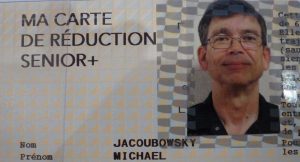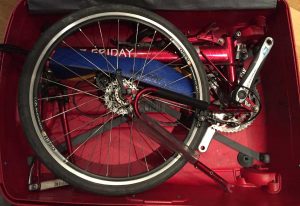Back in 2003, someone made the comment below about why seeing the Tour de France might be a waste of time. I kinda took him to task on that, as you can see below! This used to be a page on our original website, but somehow the archive has become lost, including the photos that went with it. I’ll try to reconstruct as possible. –Mike–
> You won’t get very much out of watching a road race
> in person, unless you are on a motorcycle or car following the race.
> Unless it’s a time trial, you will stand for many hours to get a few seconds
> or minutes of racing.
> If you want to ride your bicycle in France, then it’s best to avoid the
> Tour de France, as all the roads are blocked off for hours prior to
> the race.
I’ll have to disagree; there’s very little to compare to the thrill of
being on a steep mountain climb and watching the shattered peloton come
through. You are *so* close to the action that you become almost a part of
it (especially if you’re flinging a handbag around), and the drama unfolds
in front of you over a significant period of time, not fleeting seconds.
True, you’ve got to get to your place fairly early, as they’ll close the
roads to bikes about three hours ahead of the race, but the cars have been
shut out earlier than that, so you’ve got the mountain all to yourself,
along with a few hundred thousand people, many of who are cheering you on as
you climb up the col. It’s an experience like no other, a huge party that
*you* have been invited to. There will be the crazy Dutch corner (easily
identified by all the orange), the Telekom Pigs (who really don’t put
Germans in the best-possible light), the Devil himself (the guy you’ve seen
in all the photos, and yes, he enjoys having his picture taken with you!),
and a steady stream of overweight guys hauling big beer coolers miles up the
mountain.
Perhaps you’ll ride to the top of the pass, and then head back down to a
spot you scouted on the way up… but not before having your picture taken
at the very top. You descend maybe a couple of kilometers, looking for that
spot where, on the way up, you were thinking “Geez, this is a nasty
stretch!” because that’s where the attack might come.
You look at your watch and note that it’s about 2.5 hours become they come
through; quite a long time! But it passes quickly, as you trade stories
with others you meet, new friends brought to the same place as if they were
called there by some mysterious power. You try to hear what’s happening on
somebody’s radio (or, if you were really smart, you brought your own… or
perhaps even an LCD TV!). If you’ve got a cell phone and don’t mind the
cost, you call home (if that’s in the US) and ask your wife if she could
turn on OLN and let you know what’s happening (never mind that it’s 6am
there!).
Before long (two hours prior to the riders) the first competition begins…
the Caravan arrives, and everybody’s acting like a little kid, trying to
score whatever trinkets & trash they throw from the vehicles. You could
spend days studying the Caravan and never figure out how they decide who
they’re going to throw to! But eventually you start analyzing trajectories
and learn where stuff is likely to land. If you’re smart, you’ll pay
attention to the Aquarel vehicles; they pass out bottled water, which is a
very valuable commodity when you’re miles from nowhere!
The Carvan takes about 30 minutes to completely pass through; an amazing
assortment of vehicles, many of which you simply don’t believe could travel
up & down the passes safely. It’s incredibly goofy and leaves even the most
jaded with a strangely giddy feeling.
But now you’ve still got an hour and a half to go, and it seems like the
gendarmes have temporarily given up on stopping people from riding up the
hill. An occasional car goes flying through, perhaps transporting a
photographer or dignitary or race official to some key spot further down the
course. The tension is building noticeably; people are talking about
whatever strategy has unfolded so far, and wondering who’s going to be in
the lead by the time they get to your spot on the course.
By this time your neck is pretty fried if you haven’t put on sunscreen, and
your feet a bit tired if you’re trying to walk around in racing shoes
(definitely consider bringing along some of those roll-up shoe/sock things
with the rubberized soles and mesh tops). But you’re hanging tough, along
with everyone else, and something is telling you that there’s no place on
earth better to be than right where you are, at least not at this point in
time.
Half an hour to go and the gendarmes are now aggressively keeping people off
the road. Time to park your butt so nobody takes your place! And then,
with the riders maybe 20 minutes away, you see the first helicopters, way
down the valley. The first ones you see are up high; they’re used to relay
the television signals. But shortly you spot the lower helicopters, the
ones that closely follow the riders, and you can see them moving up the
valley, moving towards you. The air becomes strangely chilled for a short
period of time as you get goose-bumps in anticipation.
Ten minutes away and, for the first time, you hear the helicopters. As they
close in on you, they seem to almost slow down and hover, as if the riders
have stopped just short of you. Soon, a car comes blasting through at very
high speed, with a bull-horn blasting out in indecipherable French (as only
a bull-horn can do) that the riders are just two minutes behind! But what
riders? No way can you make out what they’re saying; it’s the worst
Jack-in-the-box speaking imaginable. But you catch bits and pieces of
conversations around you, and put together that a Frenchman’s off the front
by a minute or two but is losing ground fast, and an attack has just flown
off the front of what’s left of the pack, which is quickly disintegrating.
And then the lead motorcycles, two of them, flying fast and close to the
edges of the road in an attempt to move you back and make room for the
riders. And they *do* come very, very close. They have their prescribed
line, and I don’t know what would happen if somebody didn’t move out of the
way fast enough.
Now they’re upon you. Lead motorcycle (with photographer), and then the
stage leader, seeming to both fly and struggle at the same time (and in your
mind you could swear that each pedal stroke is slower than the one before).
This guy’s not going to make it; the attacks behind are going to swallow him
up shortly. He’s followed closely by his team car, with the DS (team
director) leaning out the window yelling encouragement (or obscenities, if
it’s Saiz).
A minute or two of silence follows, and you’re briefly thinking “Is that
it?” You know it’s not, but you’re thinking it anyway. There were just a
couple of cars, maybe four motorcycles. But then you notice the air around
you is moving and you look up and there’s helicopter hovering right over the
top of you, and noise levels are increasing at an astronomical rate as a
flotilla of cars and motorcycles rush past and you’re suddenly in the middle
of a traveling maelstrom of activity. Don’t blink now, things are
happening fast! Where are they? Motorcycles, cars, helicopters, more
motorcycles, all making quite the racket, and now the crowd is yelling,
cheering wildly, the noise literally rolling up the hill towards you. You
look down the road and notice where people are starting to yell; obviously
the riders are within their sight! Camera, is the camera ready?
At this point you have to make a decision (one you should have made some
time ago, but is now up for grabs). Do you watch the events unfold, get
caught up in the moment and cheer your heroes on… or do you take photos?
It’s an unfortunate fact that you really can’t do both… to take decent
photos requires that you become almost detached from what’s going on.
Timing is everything! Those who are there to stand and cheer will be able
to replay the event in their mind, over and over. The photographer, if
he/she doesn’t get the shot, loses everything. There’s no half-way.
Zoom in on the motorcycles. Ignore those used for crowd control; the ones
to watch for are those with photographers and race officials, as they’ll be
in the thick of the action. They’ll always have a passenger, and often a
tall antenna on the back. Right behind them, or maybe to the side, will be
the action, the racers who are doing their best to blow things apart. Your
heroes. Virenque (if it’s not the final hill). Heras. Lance. Ullrich.
Tyler. Vino. Guys who are looking very serious, like this is all-business
and they’re at 110% and refuse, absolutely refuse to crack. Their speed is
unbelievable for such a steep grade; these guys are simply not mortal. They
turn the throttle and see if they can push it to 11…and hold it there for
as long as it takes.
And then they’re passed. The helicopters, the motorcycles, the cars, the
riders… gone on up the hill. Maybe 15 seconds later you get somebody who
wasn’t able to keep up, but still doing pretty good, in no apparent danger
of falling apart. Whatever discouragement comes from falling off the back
is at least partly offset by the tremendous amount of attention that single
person is getting from the crowds! And, when you talk with them later, they
tell you they *do* hear you, and it *does* keep them going.
Another minute or two and you get a bit larger group, riders who are working
really hard, trying not to lose too much time in the GC. There’s a bit of
panic on some of their faces; nobody looks comfortable. Nobody in this
group is going to win the stage, but there still might be opportunities for
a couple of them to move up in the GC.
Now you start getting the stragglers; people who have blown up and are
steadily losing time. These guys are going visibly slower than those that
came before, and they look really, really awful. Mortal. Like you & me
when we’re totally bonked and have three miles left on nasty climb and can’t
imagine how we’ll make it over the top. No pedals turned in anger, just
anguish!
By this time things have really thinned out and maybe twenty minutes (or
more) have passed since the lead rider. You start counting in your mind how
many have passed by; it just doesn’t seem like all that many. Did everyone
drop out? But you wait a bit more and here it comes… maybe 80 guys all
bunched together, riding almost casually up the hill. Their work was done
long ago, and none of them are in contention for anything but perhaps
sprinter’s points… their only fear is the dreaded time-cut. But as long
as a large number ride together, they figure they’ll all be allowed to stay
in the race, even if they miss the time-cut, because the organizers aren’t
going to disqualify half the field!
And, finally, the broom wagon comes along, giving far too much attention to
the poor guy in front of it, the last rider on the course. This guy
probably doesn’t have a chance of making the time cut, but suffers on.
Everybody watching can relate to this poor guy, and sometimes the identity
surprises you (last year on the Tourmalet, it was Axel Merckx).
That’s what you get watching the TDF in person.



